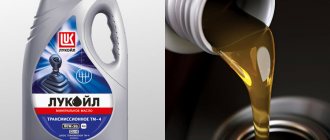Knowledge of automotive intricacies greatly helps in practice not only for those drivers who have little experience in operating a car, but also for experienced professionals. Among these important subtleties, undoubtedly, is the knowledge of what signs and how to distinguish transmission oil from motor oil.
What is motor oil and why does a car need it?
Motor oil is designed to lubricate the mechanisms in a car engine. Each individual car model requires its own motor oil with certain characteristics. Oil is classified by letters and numbers. Based on these parameters, you can clearly find out the characteristics. Motor oil usually consists of base oil obtained after oil refining and additives. Motor oil can be mineral, synthetic or semi-synthetic. In order for the car to work correctly and its service life to increase greatly, it is necessary to choose those oils that are recommended by the vehicle manufacturer.
What is gear oil?
Gear oil has increased resistance to high loads. In addition, this oil has a high viscosity, due to which it perfectly suppresses noise emitted by working mechanisms, removes heat that appears during friction and eliminates the possibility of rapid wear of components. Transmission oils should never be mixed due to the high risk of breakdowns. To change the transmission oil, it is necessary to completely drain and clean the system of old lubricant. When choosing gear oil, preference should be given to those oils recommended by the manufacturer.
Is it possible to distinguish between oils?
To visually distinguish transmission oil from motor oil, simply dip two fingers into the oil and then slowly spread them apart. The film of motor oil stretches up to 3 mm, while in transmission oil it breaks literally immediately. In addition, you can distinguish the compositions by smell. Transmission compounds may smell like garlic or sulfur. This cannot happen with motor oils.
You can learn more about the difference between engine oil and transmission oil in this video:
Information on how to distinguish motor oil from transmission oil may be of interest to both drivers and people who are just planning to buy a car. It seems much simpler: you chose a canister with the appropriate label in the store, poured oil into the designated place, put the canister with the remaining substance on a shelf in the garage - and no worries!
Motor and transmission oils differ in characteristics.
Each type of vehicle has its own oil
Since different types of transport, as well as their individual units and components, have different requirements (for example, both the conditions of use and the intensity of work differ for commercial vehicles and off-road equipment), they require separate types of oils.
Sometimes it is allowed to use the same motor or transmission oils in different vehicles - from passenger cars to heavy-duty trucks. But the oil requirements for a tractor engine and a foreign car for high-speed highways are different. And transmission oil for a tractor unit is sometimes needed several times more for a year than for a car engine for the entire period of operation.
What can cause an error when filling oil?
Filling with transmission oil will damage the engine.
To an inexperienced person, all fuels and lubricants look the same, but the ingredients of oils differ significantly from each other. Even a small volume (100-200 ml) of transmission oil poured into the engine can lead to mechanism failure. The “blame” for this is the additives to the substance, which are designed to help fulfill clearly defined tasks: to ensure the operation of mechanisms in conditions of high or low temperatures, preventing their wear.
Transmission oil is not designed to operate at elevated temperatures. Once in an environment where the temperature exceeds 150 o C, the substance begins to burn out. Scale and flakes of burnt substances form and settle on engine parts. If the owner of the car comes to his senses in time and drains the substance, the engine can be saved. Otherwise, a major engine overhaul is at risk.
The same sad consequences await the engine if oils are accidentally mixed. As you know, when adding oil to the engine, it is not allowed to mix different types of lubricant: for example, synthetic and semi-synthetic, synthetic and mineral, etc. As a result of such manipulations, the performance characteristics of the substances drop sharply, the quality deteriorates, which ultimately causes breakdown of the engine mechanisms .
Motor oil has a higher viscosity.
Even the most experienced mechanic cannot predict the consequences of mixing substances for the gearbox and engine. Today there are a large number of brands of both motor and transmission oils. Each manufacturer uses original ingredients, which, when shaken or heated, can lead to unexpected chemical reactions.
The simplest thing that can be assumed is the foaming of the substance, the formation of a heavy sediment or clots, and the substance acquiring a paste-like state.
If you add a little motor lubricant to the gearbox, you will notice not only changes in the appearance and consistency of the substance, but also a deterioration in the operation of the transmission. This will be facilitated by higher engine oil viscosity.
Some experienced drivers note that in extreme situations, engine fluid can save the situation: for example, the car is stopped, there is forest all around, you can’t call for help, the only oil you have is the transmission.
The only way out here is to pour the substance into the engine, drive to populated areas and immediately contact a service station. It will be necessary not only to replace the engine lubricant, but also to flush it.
What is a mistake worth?
Getting engine oil into the transmission is undesirable, but not critical. The properties of the lubricant will change, and the overall functioning of the unit may deteriorate. But this will still lead to fewer problems than pouring transmission oil into the crankcase.
Even a small amount of transmission fluid can disrupt the operation of the unit. This oil cannot operate at elevated temperatures and burns quickly. As a result, carbon deposits form on the internal surfaces of the engine and the oil turns into flakes, which can lead to major repairs.
How to distinguish between types of oils
Gear oil will create a rainbow-colored film on the water.
Some auto mechanics who have been working with fuels and lubricants for a long time are able to not only distinguish their purpose, but are also able to approximately name the manufacturer. Unfortunately, ordinary car enthusiasts do not have such knowledge. Therefore, it is necessary to remember 3 main methods that you can rely on if you need to determine the type of oil:
- By smell. Since transmission oil contains a large number of chemical additives, which may include fluorine, sulfur, phosphorus, molybdenum disulfide, etc., the substance has a very specific odor. Some substances smell like sulfur, others like garlic. But you should not rely on just one method of determination, since the smell could have evaporated from a loosely closed canister or the person does not have a sufficient sense of smell.
- By appearance. You need to put 2 fingers together and dip them into an unidentified substance. Then the fingers slowly spread apart. If the oil is motor oil, the film will begin to stretch behind your finger by 2-3 mm, if it is transmission oil, it will immediately break. The method should also not be considered very reliable, since sometimes only a very experienced and attentive person can notice the moment the film breaks.
- Using water is the most commonly used method and does not require special care. Pour a little clean water into a wide container (cup, bowl), and then drop in the substance to be determined. A drop that immediately spreads across the surface of the water like a rainbow film will indicate gearbox fluid. If the drop has acquired the shape of a lens and floats on the surface for some time without changing, it is motor oil.
Visual ways to distinguish engine oil from transmission oil
At first glance, the ability to distinguish motor oil from transmission oil is not important. After all, it’s easy to choose the right material in the store: there are corresponding instructions on the canisters, and the sellers will tell you. All that remains is to choose a brand and fill it into the car for its intended purpose. However, there is always an unused residue that sits in the container until you have to add oil. It is not always possible to determine the purpose of the liquid from old packaging. The driver is faced with a choice: either pour out the oil or find out its type.
Let's sum it up
High-quality oil, used as intended, guarantees the correct and uninterrupted operation of the functioning components of the machine. If a situation arises when there is a need to determine the type of oil available without identification marks, you can use simple methods, which consist of checking by smell, appearance or water testing, however, you should not trust such methods one hundred percent. The true composition of the oil can only be reliably confirmed by laboratory analysis, which is highly expensive. If, after checking the lubricant, there are still doubts about its type, it is better to refuse to use such products, throw away the remains, and buy a new motor oil. Believe me, new lubricant, regardless of whether it is intended for the engine or transmission, will cost much less than a major overhaul of the car.
Why is it important to know the purpose of the oil?
Visually, all oils look almost the same. But liquids for different purposes have different compositions. First of all, they differ in the set of additives, which is determined based on the operating conditions of the oil. Therefore, even a small amount of transmission oil that gets into the engine can significantly disrupt its operation.
Transmission oil has a composition designed for operation at low temperatures. Therefore, when it gets into the engine and gets very hot during operation, the oil burns out. This leads to the accumulation of combustion products in the engine. If transmission oil is used instead of engine oil for only a short time, after which it is drained and the engine is washed, negative consequences can be avoided. But if measures are not taken in time, everything will probably end in engine overhaul.
A serious mistake would be not only pouring transmission oil into the engine, but also mixing different types of oils. Mixing liquids with different bases (for example, synthetics and mineral water) is not allowed. Even if good oils are mixed, the result will be a material that is unusable.
Transmission fluid differences
The main task of the transmission fluid is to create a more durable oil film on the parts of this design. This requirement determines the key difference between gear oil. It is explained by the fact that the parts of the transmission rub with much greater force and receive a much greater mechanical load than in the engine, and if they are not lubricated abundantly, they wear out very quickly and fail. The composition of such a liquid is created taking into account the fact that it will have to work at a more gentle temperature regime than engine oil. Moreover, this mode is, as a rule, stable in nature, without sudden changes, as is recorded in a car engine.
How to determine the type of oil?
Experienced craftsmen, through whose hands dozens of brands of various oils have passed, claim that they can visually determine not only the purpose of the oil, but also its manufacturer. The average car enthusiast cannot do this. But there are 3 criteria that allow you to distinguish engine oil from transmission oil:
- Smell. Transmission oil has a characteristic odor due to the presence of a number of chemical elements in it (sulfur, phosphorus, fluorine, etc.). They are part of the additives used in lubricants. The reliability of this criterion is low, since over time the smell is lost, and not everyone can boast of a keen sense of smell.
- Appearance. It is necessary to check the viscosity of the oil by assessing the strength of the oil film. 2 fingers, folded together, are dipped into the liquid, removed from it and carefully spread to the sides. If the oil is motor oil, the film will stretch by 2 - 3 mm. If it’s a transmission, it will break instantly. This criterion also has a drawback: it is difficult to detect the moment the film breaks.
- Behavior on the water. The criterion is the most objective. The test consists of assessing the behavior of an oil drop in water. If you drop the transmission into water, it will immediately spread into a thin layer. If motor oil is used, the drop will retain its round shape and float on the surface.
The subjectivity of each criterion is quite high, so experts do not advise relying too much on them.
In order not to miss anything, you can subscribe to the newsletter by simply clicking on the button below!
Classification of oils
Both types of oil consist of 3 bases:
- mineral;
- semi-synthetic;
- synthetic.
Mineral oils, at their core, are simply refined petroleum. Synthetic oils are created in laboratories where they work to achieve a high level of protection of the car engine from wear.
Synthetic oils are in turn divided into fully synthetic and semi-synthetic.
* Semi-synthetic is a mixture of mineral and synthetic base oils. It provides protection indicators much higher than when using just mineral oil.
* Accordingly, a fully synthetic oil does not contain a mineral base; its components are only synthetic base oils and additives. The result is a fluid product that lubricates the parts well, ensuring their durability. The difference between synthetics is that such oil does not need to be changed frequently.










